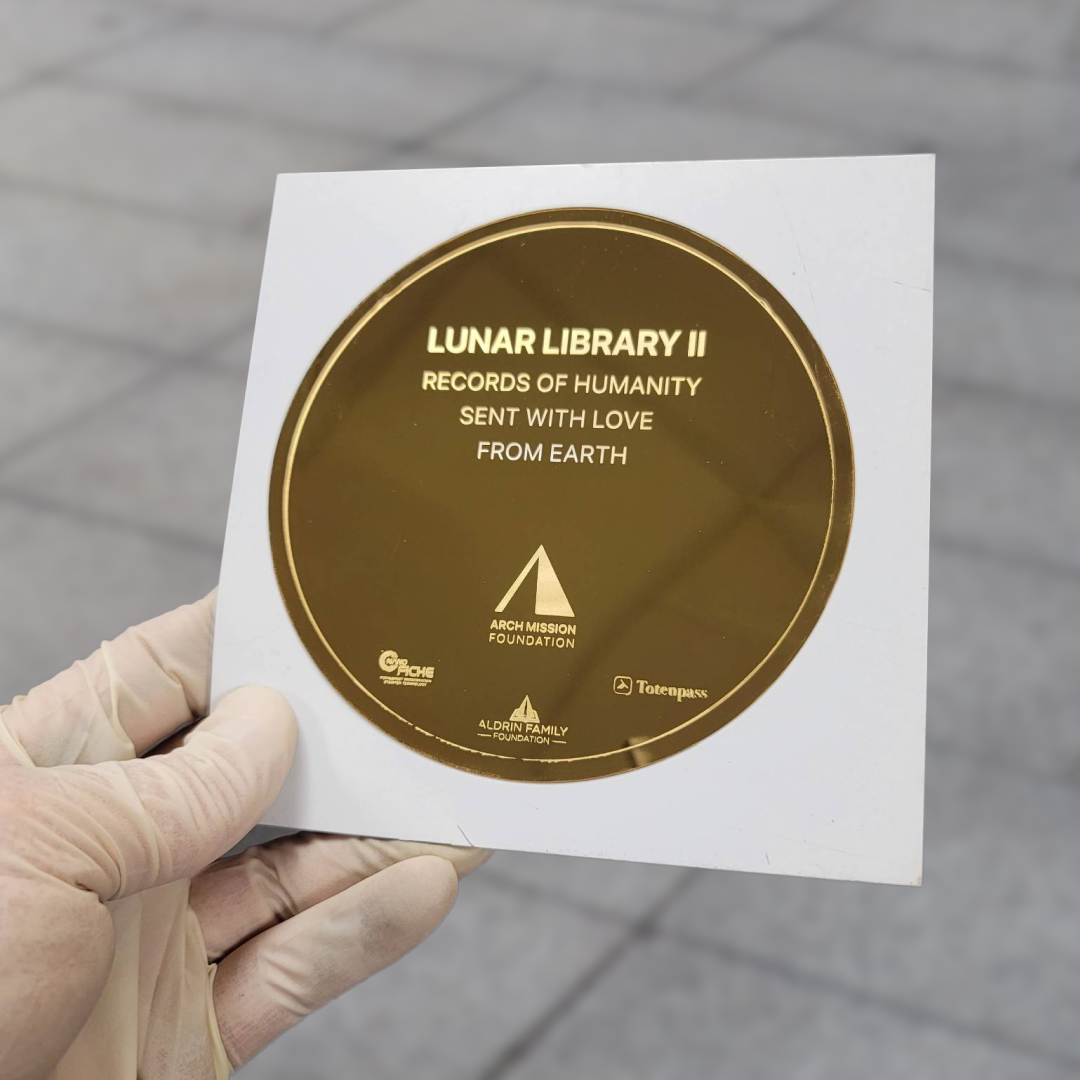
Astrobotic is sending the Lunar Library 2: the largest archive of Earth, on the Moon. In the quiet expanse of space, a new chapter of human legacy will be etched on the surface of the Moon.
The Arch Mission Foundation, a non-profit organization dedicated to the long-term preservation of earth’s heritage, has announced that the Lunar Library II set to fly to the Moon with Astrobotic in 2024.
The Lunar Library II is set to build upon its predecessor (which did not successfully land on Beresheet), on the lunar surface aboard Astrobotic’s Peregrine Lander.
This isn’t a sequel; it’s an expansion of an ambitious dream. The first Lunar Library, launched in 2019, was a pioneering step, containing 30 million pages.
Now, the second installment is a more comprehensive archive, housing more than 60 million pages of information.
What is the Lunar Library II?
The Lunar Library II is an ultra-durable archive of humanity, created by the Arch Mission Foundation.
It is an instance of The Billion Year Archive initiative, which aims to build a solar system-wide library system that can preserve, connect, and share humanity’s knowledge for eternity.
Compared to the first Lunar Library, the Lunar Library II has twice the data density and has been reorganized and improved to make it easier to decipher for future recipients.
The Lunar Library II is printed on nickel NanoFiche, an ultra-durable analog nano storage medium.
NanoFiche can be read without any advanced technology. Since it is an analog storage medium, designed to replace microfiche, it can be viewed using simple optical magnification.
Our team selected this technology because it is durable, has a high information density, and is likely to be decipherable by future recipients with similar biological traits.
The Lunar Library II also includes data stored in DNA.
Key Details
The Lunar Library II includes more than 60 million pages of information, from:
- English Wikipedia
- Literary collections from Project Gutenberg
- Selected historical records from the Internet Archive
- A linguistic key to 5,000 languages provided by the Rosetta Project and PanLex datasets.
- The Arch Mission Primer which teaches over a million concepts with images and words
- It also includes multiple datasets encoded in DNA, provided by the Molecular Information Systems Lab at the University of Washington, Catalog DNA, and LifeShip.
- Archives of music and film, and contributions from partners like SETI’s The Earthling Project, the Aldrin Family Foundation, and the Great Pause Project.
- Private collections containing tens of thousands of books, artworks, reference materials, and data sets, covering all major subjects, religions, cultures, technologies,and civilizations.
Largest archive in space. It is the largest cultural archive (in terms of data content) ever sent to space, and it is also the largest cultural archive in the smallest form factor ever made.
Will last billions of years. It will last as long as the Moon. Etched into special nickel films that are grown atom by atom using a nanotechnology process, the content of the Lunar Library II never decays.
Longest duration archive of civilization built by humans. It will remain for billions of years longer than any archive on Earth, making it perhaps the largest and longest lasting archive of human civilization ever made.
This a testament to our history and culture that will stand the test of time.
Why an Archive on The Moon?
Think of it like an off-site backup – a redundant backup plan for Planet Earth.
The Moon has influenced culture and evolution since the dawn of life on Earth. After inspiring billions throughout history, the Lunar surface is a secure and enduring repository for the collective memory of our civilization.
It is also free of the harsh weather and atmosphere of Earth. If undisturbed, we expect The Lunar Library 2 to endure for up to billions of years on the Moon.
Why this matters.
Humanity, we have a problem.
Our modern civilization, the most technically advanced in human history, has no backup.
Today’s knowledge and culture primarily exists on ephemeral digital storage mediums like hard drives and flash drives.
If a global cataclysm were to occur – such as an EMP, a solar flare, or a really bad series of cyber events – most of our collective knowledge would be gone within a few decades and it would take centuries to re-build.
The Arch Mission Foundation is working to solve this problem.
What is the Arch Mission Foundation?
The Arch Mission Foundation is a nonprofit designed to preserve human heritage forever.
Our Foundation creates and maintains ultra-long-term data storage archives called Arch Libraries. These libraries are the most durable records of human civilization ever built. Using new technologies, they preserve more knowledge for more time than anything ever created.
Our team is a dedicated group of inventors, designers, and engineers that feel we have a moral obligation to both our ancestors and our descendants to try to preserve our heritage for the far future.
Since we started in 2015, we’ve launched multiple Arch Libraries to Earth, space and to the Moon (more on the way in 2024).
This is just the beginning.
This is Act One of a multi-generational archival effort. We believe that the key to good archival work is mass redundancy. Lots of copies keep stuff safe.
Over the next decade, the Arch Mission Foundation will launch several more Libraries to locations all around planet Earth and in space to continue the pursuit of a Billion-Year Archive that can truly serve as a backup of human civilization.
This is just the beginning. And we would love your help!
If you find this endeavor of interest, please join us, to preserve our planetary heritage, for the future.
Join us and learn more at www.archmission.org

